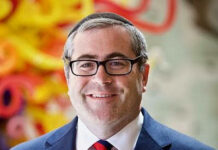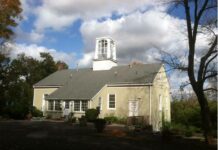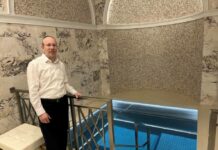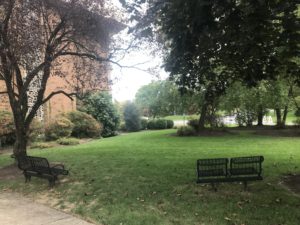
Outside of Har Zion Temple’s entrance on its west end, there’s a small field of grass. When you walk by, the area doesn’t look like much. There are three benches along the perimeter, but that’s about it.
Yet over the summer, the pocket park became a weekly feature of synagogue life. In previous years, the Penn Valley congregation would hold Shabbat services there in the warm months, according to Cantor Eliot Vogel. But only about 10 people would show up.
In 2022, though, attendance increased to an average of 30 members per week. Or, as Vogel put it, that number represented an increase of 200%.
“You have the opportunity since COVID to be inside or outside,” said Andrea Robbins, a Har Zion member for 64 years. “You can enjoy the peaceful landscape. It enhances our campus life.”
Har Zion’s pocket park is like many outdoor spaces at synagogues around the Philadelphia area: It’s now being used a little more than it was before. It’s a trend that’s difficult to quantify, but shul leaders seem to know that it’s there.
During the pandemic, congregants used virtual and outdoor spaces to still gather while protecting themselves from the airborne virus. And much like the virtual space, the outdoor one might remain a feature of synagogue life beyond the COVID situation.
Right now, that desire manifests itself in small ways, like an increase from 10 to 30 people at summer services in a patch of grass. But such gatherings and activities are happening all over.
At Congregation Kol Emet in Yardley, Rabbi Anna Boswell-Levy hosted the annual Tashlich service on the first day of Rosh Hashanah. Pre-COVID, congregants would throw their pebbles and bread crumbs into the water, to represent “casting off” sins, and be done in 15 minutes, the rabbi recalled. But this year, the event lasted two hours.
“We also ate,” Boswell-Levy said. “There was a potluck lunch after the Rosh Hashanah service.”
For years, Temple Brith Achim in King of Prussia has used nearby Lower Perkiomen Valley Park for the occasional Shabbat service, according to congregant Mark Hager, who joined in 1985. Most of those were in the summer when the weather was warm. But during the pandemic, the community began gathering in the park for winter Shabbat services, too.
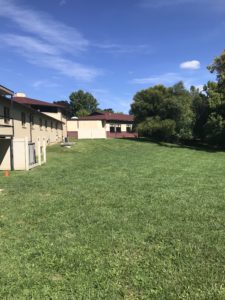
More recently, it has not even needed to go to the park. Temple Brith Achim members are just walking out their back door and using the field behind their building. It’s a long field that slopes down into a small forest, more than enough space for a Shabbat service.
“We also have Wi-Fi out here, which gives us additional capabilities we can use,” Hager said.
Also for years before the pandemic, the temple would hold weekly Havdalah services, marking the end of the Sabbath, inside its sanctuary. But for the last two years, it has held them outside with fire pits.
“The campfire Havdalah has become a regular kind of thing we’ve been doing, and that’s a lot of fun,” said Rabbi Sharon Forman-Toll, the synagogue’s educational director and a member for 38 years.
As Boswell-Levy explained, the pandemic showed how resilient Jewish communities could be in their desire to still come together. And in using the great outdoors to gather, they connected with the Earth and the natural world again. No longer were they taking it for granted.
Geoff Goll, one of Boswell-Levy’s congregants at Kol Emet, agrees with his rabbi. Goll, 54, joined the temple in 2010. He said the congregation did not do much outside before COVID — maybe gardening or building the Sukkah each year, but that was it.
During the pandemic, though, as the community used parks, patios and parking lots to get together, Goll had a few realizations. The first was that they were spending way too much time inside before.
“They say humans spend 90% of their time indoors,” he said. “When you think about that, it’s kind of sad.”
The second was that it felt good to be outside.
“It helps kind of regenerate your spirit,” Goll added.
And the third was more practical. Kol Emet had a 10-acre property in scenic Bucks County. And it was not making use of most of it.
“It’s an outdoor area that could be enjoyed by the membership as a whole and appreciated,” Goll said.
So now, this sense of appreciation is turning into real action. At Kol Emet, Goll, an engineer by trade, is leading a committee responsible for the design and construction of an outdoor sanctuary/”contemplative space,” as members call it.
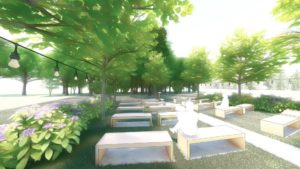
The goal, according to Goll, is to connect the synagogue campus with the forest on its property. This will give congregants “an outdoor experience but also bring them into nature,” said the engineer, whose firm, Princeton Hydro, is handling the design work.
Concept photos for the space provided by Goll show a bimah at the front, where Boswell-Levy will stand, just like in the sanctuary. The rabbi will look out over a series of benches where congregants will sit and enjoy services.
Only they will not be surrounded by walls. Instead, they will look around and see bushes, flowers, trees and even bistro lights. With the forest on one side, trees will be planted around the rest of the outdoor sanctuary to make it a true oasis.
They will, as Goll put it, “frame the space.”
“It will essentially be open air,” he added. “When the trees get big enough, they’ll provide the quote-unquote roof.”
Kol Emet’s outdoor sanctuary is part of a $750,000 capital campaign to upgrade the synagogue. Similarly large-scale projects are underway at other area shuls, too.
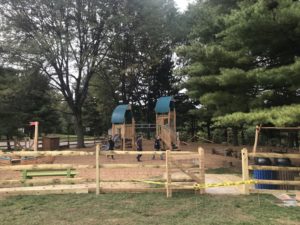
At Har Zion Temple, a $400,000 fundraising effort is going toward the expansion and renovation of a playground for preschool students. The project, funded by congregants in installments ranging from $360 to more than $5,000, will double the size of an existing playground to give kids more space to play with wood chips, pine cones and each other, according to Sara Horowitz, the congregant and mother leading the effort.
When they observed kids playing on the old playground, Horowitz and other parents noticed that their “favorite things to do” were collecting wood chips and pine cones and creating games. The new space will emphasize “child-led play,” said Horowitz, as opposed to “play that’s prescribed.”
“A lot of the research on play shows that the nature-focused playgrounds are really where the most growth can happen,” she added. “It’s a lot more risk-taking and learning on their end.”
This is in addition to an outdoor pavilion in the works at Har Zion, and a hiking trail out back that is already finished.
Temple Brith Achim is also planning to build a pavilion, according to President Steve Kantrowitz, and its garden walkway leading to the entrance is — like the hiking trail at Har Zion — already done. Kantrowitz estimates that a handful of people can gather there, too.
Being outside is not about the view, according to Gary Charlestein, a Har Zion member since his birth in 1944. It’s just about being outside.
“Being close to nature is always a good thing — even if you’re overlooking a parking lot and not overlooking a beautiful vista,” he said. “You feel the air; you hear the birds; it’s all good.” JE



